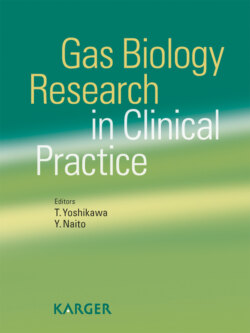Читать книгу Gas Biology Research in Clinical Practice - Группа авторов - Страница 11
На сайте Литреса книга снята с продажи.
CO Derived from HO-2 Targets Hepatic Stellate Cells to Relax Sinusoids
ОглавлениеMany years ago, we first showed that CO serves as a vasorelaxing factor that reduces sinusoidal tone and is necessary for maintenance of the microvascular perfusion [6, 7]. This is based on the fact that zinc protoporphyrin IX, a potent inhibitor of HO, abolished CO generation and simultaneously increased the baseline vascular resistance in the perfused liver. The role of endogenous CO in sinusoidal relaxation was also shown in experiments using free oxyhemoglobin which captures both NO and CO, and methemoglobin that is able to capture NO but not CO [2]: only oxyhemoglobin was able to reproduce the vasoconstrictive effect of the HO inhibitor. Although the gas appears to diffuse freely across the cell membrane, our results collected from the liver did not support such a notion: when encapsulated with liposome, oxyhemoglobin lost its ability to constrict sinusoids because of limited accessibility to the space of Disse across the endothelial fenestration, suggesting that the locus of the gas action is extrasinusoidal, perhaps involving hepatic stellate (Ito) cells. Ito cells constitute the most abundant resource of soluble guanylate cyclase in the liver that serves as a receptor for CO-responsive modest upregulation of cyclic GMP through the gas binding to the prosthetic ferrous heme of proteins.
Although a lot of evidence suggests that CO generated from HO plays a protective role against organ dysfunction, few studies have provided evidence for quantitative information of endogenous CO generation: according to previous data, local concentrations of CO in the liver under physiologic conditions appeared to be around 1 μmol/l. Under pathologic conditions including ischemia-reperfusion, acetaminophen-induced liver injury [8], endotoxemia [9] or excessive heme overloading [10], the CO concentrations reached 2-4 μmol/l. Still unclear is the extent to which NO could interact or compete with CO in vivo, mainly because of the lack of quantitative information on functionally intact NO in situ. Although sinusoidal endothelium constitutes a major cellular component of NO synthase expression, NO released from the enzyme may be entrapped by circulating erythrocytes or cancelled by superoxide anion spontaneously released from Kupffer cells [11].
Since the potency of NO to activate the cyclase is extremely greater than that of CO [12], CO appears to be able to activate soluble guanylate cyclase in vivo, but only when local NO concentrations are low. Actually, when the liver is exposed to endotoxemia to induce inducible NO synthase [9], amounts of cyclic GMP are dictated by NO but not CO. Since cyclic nucleotides upregulate the transcriptional expression of HO-1, the endotoxemic liver overexpresses HO-1; this response downregulates inducible NO synthase through degradation of the prostethic heme for this enzyme to suppress NO, and subsequently upregulates CO to maintain sinusoidal relaxation for the blood supply. Under these circumstances, CO relaxes sinusoids through cyclic GMP-independent mechanisms [9]. In this relaxation mechanism, the ability of CO to inhibit cytochrome P450 epoxygenases was suggested to be involved: in other other words, the stress-inducible CO is necessary to maintain sinusoidal blood flow and subsequently to guarantee bile output under disease conditions.
